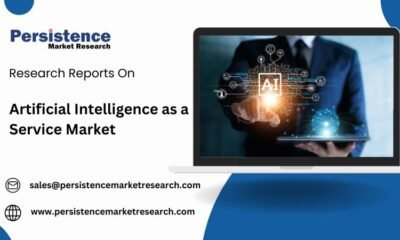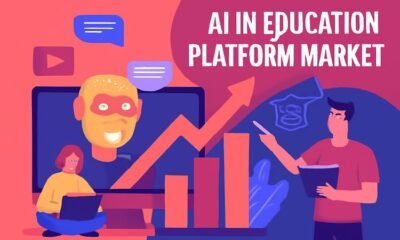Education
Voice AI in Education Market Is Going to Boom

HTF MI just released the Global Voice AI in Education Market Study, a comprehensive analysis of the market that spans more than 143+ pages and describes the product and industry scope as well as the market prognosis and status for 2025-2032. The marketization process is being accelerated by the market study’s segmentation by important regions. The market is currently expanding its reach.
Major companies profiled in Voice AI in Education Market are: Google, Amazon (Alexa), Microsoft, IBM Watson, Nuance, Baidu, iFlytek, SoundHound, Sensory Inc, Smart Sparrow, Carnegie Learning, LinguaLeo, Speechace, Deepgram, ReadSpeaker, ELSA Speak, Sonantic, Soapbox Labs, Voiceitt, Sestek.
Request PDF Sample Copy of Report: (Including Full TOC, List of Tables & Figures, Chart): https://www.htfmarketinsights.com/sample-report/4377851-voice-ai-in-education-market?utm_source=Altab_OpenPR&utm_id=Altab
HTF Market Intelligence projects that the global Voice AI in Education market will expand at a compound annual growth rate (CAGR) of 26.5% from 2025 to 2033, from USD 1.2 Billion in 2025 to USD 7.9 Billion by 2033.
The following Key Segments Are Covered in Our Report
By Type
Voice-enabled tutoring, Language learning assistants, Smart classrooms, Speech-to-text systems, Interactive reading tools
By Application
Language learning, Accessibility for disabled, Virtual classrooms, Personalized tutoring, Test prep
Definition: Voice AI in education refers to the use of speech recognition and natural language processing (NLP) technologies to facilitate learning and communication between students and educational platforms. Voice AI enables interactive language learning, assists students with disabilities, automates administrative tasks, and supports personalized tutoring. With the rise of smart devices, conversational AI, and accessibility requirements, educational institutions are adopting voice-based solutions to make learning more inclusive and engaging.
Market Trends:
• Conversational AI in classrooms, Multilingual support, Gamified voice learning, Integration with LMS, Voice biometrics
Market Drivers:
• AI adoption in education, Rising need for personalized learning, Growth of voice-enabled devices, Inclusivity goals, EdTech boom
Market Challenges:
• Privacy concerns, Accent recognition issues, High development cost, Data security, Low adoption in rural schools
Dominating Region:
North America
Fastest-Growing Region:
Asia-Pacific
Buy Now Latest Edition of Voice AI in Education Market Report: https://www.htfmarketinsights.com/buy-now?format=1&report=4377851
The titled segments and sub-section of the market are illuminated below:
In-depth analysis of Voice AI in Education market segments by Types: Voice-enabled tutoring, Language learning assistants, Smart classrooms, Speech-to-text systems, Interactive reading tools
Detailed analysis of Voice AI in Education market segments by Applications: Language learning, Accessibility for disabled, Virtual classrooms, Personalized tutoring, Test prep
Geographically, the detailed analysis of consumption, revenue, market share, and growth rate of the following regions:
• The Middle East and Africa (South Africa, Saudi Arabia, UAE, Israel, Egypt, etc.)
• North America (United States, Mexico & Canada)
• South America (Brazil, Venezuela, Argentina, Ecuador, Peru, Colombia, etc.)
• Europe (Turkey, Spain, Turkey, Netherlands Denmark, Belgium, Switzerland, Germany, Russia UK, Italy, France, etc.)
• Asia-Pacific (Taiwan, Hong Kong, Singapore, Vietnam, China, Malaysia, Japan, Philippines, Korea, Thailand, India, Indonesia, and Australia).
Have different Market Scope & Business Objectives; Enquire for customized study: https://www.htfmarketinsights.com/report/4377851-voice-ai-in-education-market?utm_source=Altab_OpenPR&utm_id=Altab
Voice AI in Education Market Research Objectives:
– Focuses on the key manufacturers, to define, pronounce and examine the value, sales volume, market share, market competition landscape, SWOT analysis, and development plans in the next few years.
– To share comprehensive information about the key factors influencing the growth of the market (opportunities, drivers, growth potential, industry-specific challenges and risks).
– To analyze the with respect to individual future prospects, growth trends and their involvement to the total market.
– To analyze reasonable developments such as agreements, expansions new product launches, and acquisitions in the market.
– To deliberately profile the key players and systematically examine their growth strategies.
FIVE FORCES & PESTLE ANALYSIS:
In order to better understand market conditions five forces analysis is conducted that includes the Bargaining power of buyers, Bargaining power of suppliers, Threat of new entrants, Threat of substitutes, and Threat of rivalry.
• Political (Political policy and stability as well as trade, fiscal, and taxation policies)
• Economical (Interest rates, employment or unemployment rates, raw material costs, and foreign exchange rates)
• Social (Changing family demographics, education levels, cultural trends, attitude changes, and changes in lifestyles)
• Technological (Changes in digital or mobile technology, automation, research, and development)
• Legal (Employment legislation, consumer law, health, and safety, international as well as trade regulation and restrictions)
• Environmental (Climate, recycling procedures, carbon footprint, waste disposal, and sustainability)
Get customized report 👉 https://www.htfmarketinsights.com/customize/4377851-voice-ai-in-education-market?utm_source=Altab_OpenPR&utm_id=Altab
Points Covered in Table of Content of Global Voice AI in Education Market:
Chapter 01 – Voice AI in Education Executive Summary
Chapter 02 – Market Overview
Chapter 03 – Key Success Factors
Chapter 04 – Global Voice AI in Education Market – Pricing Analysis
Chapter 05 – Global Voice AI in Education Market Background or History
Chapter 06 – Global Voice AI in Education Market Segmentation (e.g. Type, Application)
Chapter 07 – Key and Emerging Countries Analysis Worldwide Voice AI in Education Market
Chapter 08 – Global Voice AI in Education Market Structure & worth Analysis
Chapter 09 – Global Voice AI in Education Market Competitive Analysis & Challenges
Chapter 10 – Assumptions and Acronyms
Chapter 11 – Voice AI in Education Market Research Methodology
Thanks for reading this article; you can also get individual chapter-wise sections or region-wise report versions like North America, LATAM, Europe, Japan, Australia or Southeast Asia.
Contact Us:
Nidhi Bhavsar (PR & Marketing Manager)
HTF Market Intelligence Consulting Private Limited
Phone: +15075562445
sales@htfmarketreport.com
About Author:
HTF Market Intelligence Consulting is uniquely positioned to empower and inspire with research and consulting services to empower businesses with growth strategies, by offering services with extraordinary depth and breadth of thought leadership, research, tools, events, and experience that assist in decision-making.
This release was published on openPR.
Education
If we are going to build AI literacy into every level of learning, we must be able to measure it

Everywhere you look, someone is telling students and workers to “learn AI.”
It’s become the go-to advice for staying employable, relevant and prepared for the future. But here’s the problem: While definitions of artificial intelligence literacy are starting to emerge, we still lack a consistent, measurable framework to know whether someone is truly ready to use AI effectively and responsibly.
And that is becoming a serious issue for education and workforce systems already being reshaped by AI. Schools and colleges are redesigning their entire curriculums. Companies are rewriting job descriptions. States are launching AI-focused initiatives.
Yet we’re missing a foundational step: agreeing not only on what we mean by AI literacy, but on how we assess it in practice.
Two major recent developments underscore why this step matters, and why it is important that we find a way to take it before urging students to use AI. First, the U.S. Department of Education released its proposed priorities for advancing AI in education, guidance that will ultimately shape how federal grants will support K-12 and higher education. For the first time, we now have a proposed federal definition of AI literacy: the technical knowledge, durable skills and future-ready attitudes required to thrive in a world influenced by AI. Such literacy will enable learners to engage and create with, manage and design AI, while critically evaluating its benefits, risks and implications.
Second, we now have the White House’s American AI Action Plan, a broader national strategy aimed at strengthening the country’s leadership in artificial intelligence. Education and workforce development are central to the plan.
Related: A lot goes on in classrooms from kindergarten to high school. Keep up with our free weekly newsletter on K-12 education.
What both efforts share is a recognition that AI is not just a technological shift, it’s a human one. In many ways, the most important AI literacy skills are not about AI itself, but about the human capacities needed to use AI wisely.
Sadly, the consequences of shallow AI education are already visible in workplaces. Some 55 percent of managers believe their employees are AI-proficient, while only 43 percent of employees share that confidence, according to the 2025 ETS Human Progress Report.
One can say that the same perception gap exists between school administrators and teachers. The disconnect creates risks for organizations and reveals how assumptions about AI literacy can diverge sharply from reality.
But if we’re going to build AI literacy into every level of learning, we have to ask the harder question: How do we both determine when someone is truly AI literate and assess it in ways that are fair, useful and scalable?
AI literacy may be new, but we don’t have to start from scratch to measure it. We’ve tackled challenges like this before, moving beyond check-the-box tests in digital literacy to capture deeper, real-world skills. Building on those lessons will help define and measure this next evolution of 21st-century skills.
Right now, we often treat AI literacy as a binary: You either “have it” or you don’t. But real AI literacy and readiness is more nuanced. It includes understanding how AI works, being able to use it effectively in real-world settings and knowing when to trust it. It includes writing effective prompts, spotting bias, asking hard questions and applying judgment.
This isn’t just about teaching coding or issuing a certificate. It’s about making sure that students, educators and workers can collaborate in and navigate a world in which AI is increasingly involved in how we learn, hire, communicate and make decisions.
Without a way to measure AI literacy, we can’t identify who needs support. We can’t track progress. And we risk letting a new kind of unfairness take root, in which some communities build real capacity with AI and others are left with shallow exposure and no feedback.
Related: To employers, AI skills aren’t just for tech majors anymore
What can education leaders do right now to address this issue? I have a few ideas.
First, we need a working definition of AI literacy that goes beyond tool usage. The Department of Education’s proposed definition is a good start, combining technical fluency, applied reasoning and ethical awareness.
Second, assessments of AI literacy should be integrated into curriculum design. Schools and colleges incorporating AI into coursework need clear definitions of proficiency. TeachAI’s AI Literacy Framework for Primary and Secondary Education is a great resource.
Third, AI proficiency must be defined and measured consistently, or we risk a mismatched state of literacy. Without consistent measurements and standards, one district may see AI literacy as just using ChatGPT, while another defines it far more broadly, leaving students unevenly ready for the next generation of jobs.
To prepare for an AI-driven future, defining and measuring AI literacy must be a priority. Every student will be graduating into a world in which AI literacy is essential. Human resources leaders confirmed in the 2025 ETS Human Progress Report that the No. 1 skill employers are demanding today is AI literacy. Without measurement, we risk building the future on assumptions, not readiness.
And that’s too shaky a foundation for the stakes ahead.
Amit Sevak is CEO of ETS, the largest private educational assessment organization in the world.
Contact the opinion editor at opinion@hechingerreport.org.
This story about AI literacy was produced by The Hechinger Report, a nonprofit, independent news organization focused on inequality and innovation in education. Sign up for Hechinger’s weekly newsletter.
Education
“AI Is No Longer the Future, It’s Here: Education Must Embrace the Change”

Like every other sector, the field of education is no longer untouched by the sweeping transformation brought by Artificial Intelligence (AI). While educators worldwide are still debating how best to adapt to this new reality, a recent seminar in Kolkata underscored one clear message: AI is no longer the future—it is the present, and ignoring it is not an option. Souvik Ghosh reports
 “Just like the invention of electricity saved us from studying under lamps, AI is only a tool that will help us in our education—we must adopt it,” said Mumbai-based Epiq Capital Director Navjot Mallika Kaur as she joined other panelists in stressing the importance of AI in the education system at a seminar in Kolkata titled “Future of Education in the Age of Artificial Intelligence.”
“Just like the invention of electricity saved us from studying under lamps, AI is only a tool that will help us in our education—we must adopt it,” said Mumbai-based Epiq Capital Director Navjot Mallika Kaur as she joined other panelists in stressing the importance of AI in the education system at a seminar in Kolkata titled “Future of Education in the Age of Artificial Intelligence.”
Organised by Muskaan, Education For All, the WFUNA Foundation, and the United Nations, the seminar was inaugurated by Darrin Farrant, Director of the United Nations Information Centre (UNIC), who felt AI should be embraced boldly.
Kaur emphasized the urgency of integrating AI into education, citing how thousands of schools in China are already using it to prepare children for the future.
“I have done a lot of research on what Chinese schools are doing. Around 2,000 schools there have adopted AI, and they’re not shying away from it. They’re actually using it to make children future-ready. That’s a reality we must embrace instead of judging or running away from it,” she said.
“AI gives us opportunities. We remain the masters. Irrespective of age, ChatGPT or any AI tool can act as an assistant, helping us sharpen our capacities to get things done,” she noted.
Kolkata-born Kaur further remarked: “The quality of schools and teachers here is already very high, but we must update ourselves in the age of AI. Teachers need to become friends with technology rather than fear it or only dabble in the basics.”
Samyak Chakrabarty, founder of Workverse, added: “West Bengal has always been a hub of vibrant conversations on art and culture, as it should be. But now it’s equally important to bring AI into the dialogue. With Bengal’s unparalleled creativity and intellectual fearlessness, combining this with the computing power of AI can produce extraordinary outcomes.”
 The audience included students and teachers from schools like Don Bosco (Park Circus) and The BSS School. Many teachers expressed cautious optimism, acknowledging that AI’s rapid rise is reshaping traditional curricula.
The audience included students and teachers from schools like Don Bosco (Park Circus) and The BSS School. Many teachers expressed cautious optimism, acknowledging that AI’s rapid rise is reshaping traditional curricula.
Addressing the gap between traditional and technology-driven education, Bizongo co-founder Aniket Deb emphasized the enduring role of human agency.
“Learning has never been more important. Even with Google Maps, humans still need to input the start and end points. Education is about survival first, then thriving. Progress won’t stop just because jobs change—humanity doesn’t work that way,” he explained.
Deb, who co-founded Bizongo in 2015 inspired by Prime Minister Narendra Modi’s Make in India initiative, urged students to focus sharply on their interests. “Transitions always create new jobs. Students who consciously choose their subjects and directions will shine. The ability to choose—even deciding which AI tool to use—will define the future,” he stressed.
Entrepreneur Arjun Vaidya, founder of Dr. Vaidya’s and sixth-generation inheritor of a 150-year-old Ayurvedic legacy, raised questions about the relevance of rote learning in the AI age.
 Recalling his own schooling, Vaidya said: “I used to paste chart papers full of dates and notes on my walls to memorize them. But now, students don’t need to mug up those dates—they’re just a click away. What matters is understanding the significance of those dates and how they shaped history.”
Recalling his own schooling, Vaidya said: “I used to paste chart papers full of dates and notes on my walls to memorize them. But now, students don’t need to mug up those dates—they’re just a click away. What matters is understanding the significance of those dates and how they shaped history.”
According to UNIC Director Darrin Farrant, the UN General Assembly this week announced two initiatives to enhance global cooperation on AI governance. First, the establishment of the UN Independent International Scientific Panel on AI; and second, a global dialogue on AI governance. These steps aim to harness AI’s benefits while managing its risks.
“India, home to one-sixth of humanity, will be a key player in this journey. We must embrace AI boldly, but also ethically and inclusively,” said Farrant, marking his first visit to Kolkata.
IBNS-TWF
Education
South Pasadena School Board to Discuss Student Smartphone Ban, AI in Classrooms & New Health Benefits | The South Pasadenan

The South Pasadena Unified School District (SPUSD) Board of Education will hold its next regular meeting on Tuesday, September 9, 2025. The meeting will address a wide range of topics, including the first reading of numerous new and revised district policies, approval of several student trips, and key financial decisions for the 2025-2026 school year.
The meeting will be held at the SPUSD District Office Board Room, located at 1100 El Centro Street, South Pasadena, CA 91030. The closed session begins at 5:30 p.m., followed by the open session at 6:30 p.m. The public is welcome to attend in person or watch the livestream.
For those wishing to address the Board, speaker cards must be submitted before the meeting begins. Comments are limited to three minutes per speaker. The full agenda and supporting materials are available on the district’s website.
Major Policy Revisions on the Agenda
The Board will conduct a first reading of updates to numerous district policies, driven by new state laws and recent court decisions. Key proposed changes include:
-
Student Smartphone Use: A new policy will be developed by July 1, 2026, to limit or prohibit student use of smartphones at school sites, in accordance with AB 3216.
-
Nondiscrimination and Harassment: Policies are being updated to reflect SB 1137, which expands the definition of discrimination to include the combination of two or more protected characteristics. Updates also address the Tennessee v. Cardona court decision related to Title IX regulations.
-
Instructional Materials: A new court ruling (Mahmoud v. Taylor) prompts updates to policies on religious beliefs and sexual health instruction, affirming parents’ right to be notified and opt their children out of certain instructional content that interferes with their religious development.
-
School Safety and Student Health: The Comprehensive Safety Plan will be updated to include high expectations for staff conduct and training. Other policies address suicide prevention strategies and opioid safety, including allowing students to carry fentanyl test strips and naloxone.
These policies will be presented for final approval at the October 14, 2025, board meeting.
Financial Decisions and Contracts
The Board is set to take action on several key financial items. It will vote to approve the 2024-2025 Unaudited Actuals Report, a state-required fiscal report that finalizes the previous year’s budget figures. Additionally, the Board will consider a resolution to adopt the annual Gann Limit, which is intended to constrain government spending growth.
Several significant contracts are also up for approval, including:
-
An agreement with the Los Angeles County Office of Education for $9,100 to provide professional development on generative artificial intelligence (AI) for middle and high school faculty.
-
Contracts with several non-public schools and agencies to provide services for special education students, totaling nearly $1.2 million.
-
Approval of commercial warrants totaling $2,499,234.93 issued between July 31 and August 25, 2025.
-
Resolutions to change the district’s health care provider to Self-Insured Schools of California III (SISC III) for all employee groups, a move expected to result in significant savings. The change would be effective January 1, 2026.
Student Enrichment and Recognitions
The agenda includes the approval of several overnight field trips for students across the district:
-
5th Grade: Students from Arroyo Vista, Marengo, and Monterey Hills elementary schools will attend Outdoor Science School in Wrightwood, California, in October.
-
7th Grade: Approximately 155 middle school students will travel to Pali Institute in Running Springs for an outdoor education camp from November 7-9, 2025.
-
High School: Three SkillsUSA students will travel to Washington, D.C., to participate in the Washington Leadership Training Institute Conference from September 19-24, 2025.
The costs for these trips will be covered by parent donations, PTA funds, and fundraising, with assurances that no student will be denied participation due to an inability to pay.
Finally, the Board will formally introduce the new Student Board Member, Maeve DeStefano, and recognize the District Teachers of the Year.
-

 Business1 week ago
Business1 week agoThe Guardian view on Trump and the Fed: independence is no substitute for accountability | Editorial
-
Tools & Platforms4 weeks ago
Building Trust in Military AI Starts with Opening the Black Box – War on the Rocks
-

 Ethics & Policy1 month ago
Ethics & Policy1 month agoSDAIA Supports Saudi Arabia’s Leadership in Shaping Global AI Ethics, Policy, and Research – وكالة الأنباء السعودية
-

 Events & Conferences4 months ago
Events & Conferences4 months agoJourney to 1000 models: Scaling Instagram’s recommendation system
-

 Jobs & Careers2 months ago
Jobs & Careers2 months agoMumbai-based Perplexity Alternative Has 60k+ Users Without Funding
-

 Education2 months ago
Education2 months agoVEX Robotics launches AI-powered classroom robotics system
-

 Podcasts & Talks2 months ago
Podcasts & Talks2 months agoHappy 4th of July! 🎆 Made with Veo 3 in Gemini
-

 Education2 months ago
Education2 months agoMacron says UK and France have duty to tackle illegal migration ‘with humanity, solidarity and firmness’ – UK politics live | Politics
-

 Funding & Business2 months ago
Funding & Business2 months agoKayak and Expedia race to build AI travel agents that turn social posts into itineraries
-

 Podcasts & Talks2 months ago
Podcasts & Talks2 months agoOpenAI 🤝 @teamganassi






















